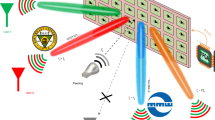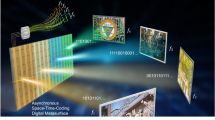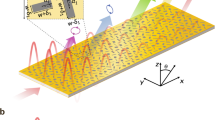Abstract
Digitally programmable metasurfaces are of potential use in next-generation mobile communications due to their ability to perform wireless data transmission without digital-to-analogue conversion or frequency mixing. However, communication networks based on programmable metasurfaces currently suffer from relatively low data transmission rates and low information mapping efficiencies (where the transmitted information per unit switching time is much lower than the information that encodes the programmable pattern). Here we report a programmable metasurface antenna that can approach the theoretical upper limit of the information mapping efficiency. Our approach combines non-recurrent encoding with spatial harmonic retrieval, and we show that the model maps most available programmable patterns to the first-harmonic direction in bijection. As a result, the approach can retrieve all of the encoding information through a single measurement. We also optimize the power efficiency of the communication architecture by using cascaded encoding to amplify the far-field radiation exclusively in the harmonic angles.
This is a preview of subscription content, access via your institution
Access options
Access Nature and 54 other Nature Portfolio journals
Get Nature+, our best-value online-access subscription
$32.99 / 30 days
cancel any time
Subscribe to this journal
Receive 12 digital issues and online access to articles
$119.00 per year
only $9.92 per issue
Buy this article
- Purchase on SpringerLink
- Instant access to full article PDF
Prices may be subject to local taxes which are calculated during checkout





Similar content being viewed by others
Data availability
The data that support the findings of this study are available from the corresponding authors upon reasonable request.
References
Shafi, M. et al. 5G: a tutorial overview of standards, trials, challenges, deployment, and practice. IEEE J. Sel. Areas Commun. 35, 1201–1221 (2017).
Yu, H., Lee, H. & Jeon, H. What is 5G? Emerging 5G mobile services and network requirements. Sustainability 9, 1848 (2017).
Zong, B. et al. 6G technologies: key drivers, core requirements, system architectures, and enabling technologies. IEEE Veh. Technol. Mag. 14, 18–27 (2019).
Tariq, F. et al. A speculative study on 6G. IEEE Wirel. Commun. 27, 118–125 (2020).
Wang, J. H., Ling, X. T., Ye, Y. W., Huang, Y. M. & You, X. H. Blockchain-enabled wireless communications: a new paradigm towards 6G. Natl Sci. Rev. 8, nwab069 (2021).
Yang, X. et al. Hardware-constrained millimeter-wave systems for 5G: challenges, opportunities, and solutions. IEEE Commun. Mag. 57, 44–50 (2019).
Cui, T. J., Liu, S., Bai, G. D. & Ma, Q. Direct transmission of digital message via programmable coding metasurface. Research 2019, 2584509 (2019).
Zhao, J. et al. Programmable time-domain digital-coding metasurface for non-linear harmonic manipulation and new wireless communication systems. Natl Sci. Rev. 6, 231–238 (2019).
Zhang, L. et al. A wireless communication scheme based on space- and frequency-division multiplexing using digital metasurfaces. Nat. Electron. 4, 218–227 (2021).
Chen, M. Z. et al. Accurate and broadband manipulations of harmonic amplitudes and phases to reach 256 QAM millimeter-wave wireless communications by time-domain digital coding metasurface. Natl Sci. Rev. 9, nwab134 (2022).
Zhang, X. G. et al. A metasurface-based light-to-microwave transmitter for hybrid wireless communications. Light Sci. Appl. 11, 126 (2022).
Wu, G. B. et al. A universal metasurface antenna to manipulate all fundamental characteristics of electromagnetic waves. Nat. Commun. 14, 5155 (2023).
Wu, G. B., Dai, J. Y., Cheng, Q., Cui, T. J. & Chan, C. H. Sideband-free space-time-coding metasurface antennas. Nat. Electron. 5, 808–819 (2022).
Dai, J. Y. et al. Wireless communications through a simplified architecture based on time-domain digital coding metasurface. Adv. Mater. Technol. 4, 1900044 (2019).
Ke, J. C. et al. Space-frequency-polarization-division multiplexed wireless communication system using anisotropic space-time-coding digital metasurface. Natl Sci. Rev. 9, nwac225 (2022).
Tang, W. et al. Wireless communications with programmable metasurface: new paradigms, opportunities, and challenges on transceiver design. IEEE Wirel. Commun. 27, 180–187 (2020).
Tan, H. et al. A free-space orbital angular momentum multiplexing communication system based on a metasurface. Laser Photonics Rev. 13, 1800278 (2019).
Li, N. et al. A broadband dual-polarized reflective metasurface for THz OAM communication. IEEE Trans. Microw. Theory Tech. 72, 1302–1311 (2024).
Tao, J. Mass-manufactured beam-steering metasurfaces for high-speed full-duplex optical wireless-broadcasting communications. Adv. Mater. 34, 2106080 (2022).
Cui, T. J., Qi, M. Q., Wan, X., Zhao, J. & Cheng, Q. Coding metamaterials, digital metamaterials, and programmable metamaterials. Light Sci. Appl. 3, e218 (2014).
Li, L. et al. Electromagnetic reprogrammable coding-metasurface holograms. Nat. Commun. 8, 197 (2017).
Li, L. et al. Intelligent metasurface imager and recognizer. Light Sci. Appl. 8, 97 (2019).
Nooraiepour, A., Vosoughitabar, S., Wu, C.-T. M., Bajwa, W. U. & Mandayam, N. B. Programming wireless security through learning-aided spatiotemporal digital coding metamaterial antenna. Adv. Intell. Syst. 5, 2300341 (2023).
Vosoughitabar, S. & Wu, C.-T. M. Programming nonreciprocity and harmonic beam steering via a digitally space-time-coded metamaterial antenna. Sci. Rep. 13, 7338 (2023).
Zhang, X. G. et al. An optically driven digital metasurface for programming electromagnetic functions. Nat. Electron. 3, 165–171 (2020).
Ma, Q. et al. Smart metasurface with self-adaptively reprogrammable functions. Light Sci. Appl. 8, 98 (2019).
Zhang, L. et al. Space-time-coding digital metasurfaces. Nat. Commun. 9, 4334 (2018).
Zhang, L. et al. Breaking reciprocity with space-time-coding digital metasurfaces. Adv. Mater. 31, 1904069 (2019).
Chen, B. W. et al. Electrically addressable integrated intelligent terahertz metasurface. Sci. Adv. 8, eadd1296 (2022).
Li, L. L. et al. Machine-learning reprogrammable metasurface imager. Nat. Commun. 10, 1082 (2019).
Wu, H. et al. Robust spin-momentum coupling induced by parity-time symmetric spatiotemporal metasurface. Adv. Opt. Mater. 9, 2101322 (2021).
Chen, X. Q., Zhang, L., Liu, S. & Cui, T. J. Artificial neural network for direction-of-arrival estimation and secure wireless communications via space-time-coding digital metasurfaces. Adv. Opt. Mater. 10, 2201900 (2022).
Cui, T. J., Liu, S. & Li, L. L. Information entropy of coding metasurface. Light Sci. Appl. 5, e16172 (2016).
Wu, H. et al. Information theory of metasurfaces. Natl Sci. Rev. 7, 561–571 (2020).
Tsai, D. P. Exploring the electromagnetic information of metasurfaces. Natl Sci. Rev. 7, 1845–1846 (2020).
Wu, H. et al. Harmonic information transitions of spatiotemporal metasurfaces. Light Sci. Appl. 9, 198 (2020).
Wang, S. R. et al. Manipulations of multi-frequency waves and signals via multi-partition asynchronous space-time-coding digital metasurface. Nat. Commun. 14, 5377 (2023).
Li, W. H. et al. Intelligent metasurface system for automatic tracking of moving targets and wireless communications based on computer vision. Nat. Commun. 14, 989 (2023).
Bai, X., Tan, S., Mikki, S., Li, E. & Cui, T. J. Information-theoretic measures for reconfigurable metasurface-enabled direct digital modulation systems: an electromagnetic perspective. Prog. Electromagn. Res. 179, 1–18 (2024).
Huang, C., Zappone, A., Alexandropoulos, G. C., Debbah, M. & Yuen, C. Reconfigurable intelligent surfaces for energy efficiency in wireless communication. IEEE Trans. Wirel. Commun. 18, 4157–4170 (2019).
Wu, Q. & Zhang, R. Intelligent reflecting surface enhanced wireless network via joint active and passive beamforming. IEEE Trans. Wirel. Commun. 18, 5394–5409 (2019).
Han, Y., Tang, W., Jin, S., Wen, C. & Ma, X. Large intelligent surface-assisted wireless communication exploiting statistical CSI. IEEE Trans. Veh. Technol. 68, 8238–8242 (2019).
Di Renzo, M. et al. Reconfigurable intelligent surfaces vs. relaying: differences, similarities, and performance comparison. IEEE Open J. Commun. Soc. 1, 798–807 (2020).
Di Renzo, M. et al. Smart radio environments empowered by reconfigurable intelligent surfaces: how it works, state of research, and the road ahead. IEEE J. Sel. Areas Commun. 38, 2450–2525 (2020).
Tang, W. K. et al. Wireless communications with reconfigurable intelligent surface: path loss modeling and experimental measurement. IEEE Trans. Wirel. Commun. 20, 421–439 (2021).
Zhang, Z. Z. et al. Active RIS vs. passive RIS: which will prevail in 6G? IEEE Trans. Commun. 71, 1707–1725 (2022).
Cheng, Q. et al. Reconfigurable intelligent surfaces: simplified-architecture transmitters—from theory to implementations. Proc. IEEE 110, 1266–1289 (2022).
Trichopoulos, G. C. et al. Design and evaluation of reconfigurable intelligent surfaces in real-world environment. IEEE Open J. Commun. Soc. 3, 462–474 (2022).
Yu, F. T. S. Entropy and Information Optics-Connecting Information and Time 2nd edn (CRC Press, 2017).
Yatagai, T. Fourier Theory in Optics and Optical Information Processing 1st edn (CRC Press, 2022).
Ingleton, A. W. The rank of circulant matrices. J. Lond. Math. Soc. s1–31, 445–460 (1956).
Acknowledgements
This work was supported in part by the National Natural Science Foundation of China under grant nos. 62288101 (T.J.C.), 62171124 (T.J.C.) and 62225108 (T.J.C.); in part by the National Key Research and Development Program of China under grant nos. 2021YFA1401002 (T.J.C.) and 2018YFA070194 (T.J.C.); in part by the 111 Project under grant no. 111-2-05 (T.J.C.); in part by the Fundamental Research Funds for Central Universities under grant nos. 2242022k30004 (T.J.C.), 2242022R10055 (T.J.C.) and 2242022R10185 (T.J.C.); in part by NRF-CRP22-2019-0006 (Y.L.); in part by NRF-CRP23-2019-0007 (Y.L.); in part by the Distinguished Professor Fund of Jiangsu Province under grant no. 1004-YQR24010 (Y.L.); in part by the Fundamental Research Funds for the Central Universities, NUAA, under grant no. NE2024007 (Y.L.); and in part by The Ministry of Education, Singapore, under its MOE ARF Tier 2 (MOE-T2EP50223-0020, Y.Z.). Any opinions, findings, and conclusions or recommendations expressed in this material are those of the author(s) and do not reflect the views of the Ministry of Education, Singapore.
Author information
Authors and Affiliations
Contributions
T.J.C. and H.W. conceived the idea. H.W. and R.S. developed and carried out the theoretical analysis. R.S. and H.W. designed the programmable metasurface antenna and carried out the measurements. Z.X. and Z.Q. participated in the experimental design. Z.X., Y.L., Y.Z., J.W.W., S.T., X.W. and Q.C. participated in the analysis and discussion of the results. T.J.C., Y.L. and Y.Z. supervised the whole project. H.W., R.S., Z.X., T.J.C. and Y.L. wrote the paper with input from all other authors.
Corresponding authors
Ethics declarations
Competing interests
The authors declare no competing interests.
Peer review
Peer review information
Nature Electronics thanks Chung-Tse Wu and the other, anonymous, reviewer(s) for their contribution to the peer review of this work.
Additional information
Publisher’s note Springer Nature remains neutral with regard to jurisdictional claims in published maps and institutional affiliations.
Supplementary information
Supplementary Information
Supplementary Sections 1–21, Figs. 1–19 and Table 1.
Rights and permissions
Springer Nature or its licensor (e.g. a society or other partner) holds exclusive rights to this article under a publishing agreement with the author(s) or other rightsholder(s); author self-archiving of the accepted manuscript version of this article is solely governed by the terms of such publishing agreement and applicable law.
About this article
Cite this article
Wu, H., Shao, R., Xu, Z. et al. A programmable metasurface antenna that approaches the wireless information mapping limit. Nat Electron 8, 179–191 (2025). https://doi.org/10.1038/s41928-024-01298-7
Received:
Accepted:
Published:
Issue date:
DOI: https://doi.org/10.1038/s41928-024-01298-7



